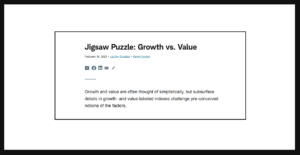Growth vs. Value: A Complex Puzzle
The distinction between growth and value stocks isn’t always clear, as index methodologies differ significantly in how they classify companies. Recent shifts in sector weightings and index rebalancing have led to discrepancies between conventional perceptions and actual index compositions. Investors should be aware of these nuances, as they impact performance comparisons and investment strategies.
CONTENTS:
- Understanding Growth and Value Indexes
- Performance Trends and Key Insights
- Case Study: December 2022 Rebalancing
- Uneven Growth Performance
- Year-to-Date Index Performance (Through February 14, 2025)
- Sector Weighting Variations
- Changes in Growth and Value Composition
- Key Takeaways

Growth vs. Value: A Complex Puzzle
The distinction between growth and value investing is often oversimplified, but a closer look at growth- and value-focused indexes reveals deeper complexities that challenge traditional assumptions.
Understanding Growth and Value Indexes
The growth vs. value debate is often intense, but context is crucial in these discussions. Among the widely tracked growth and value indexes are those from Russell and S&P Dow Jones, including:
- Large-Cap Growth & Value: Russell 1000 Growth, Russell 1000 Value
- Small-Cap Growth & Value: Russell 2000 Growth, Russell 2000 Value
- S&P 500 Indexes: S&P 500 Pure Growth (strictly growth), S&P 500 Growth (traditional growth with overlap), S&P 500 Pure Value (strictly value), S&P 500 Value (traditional value with overlap)
Russell’s methodology applies probability-based models, assigning growth and value scores, allowing some stocks to exhibit characteristics of both styles. Russell’s growth indexes prioritize forward-looking analyst forecasts, whereas S&P relies more on historical price momentum. Additionally, Russell’s value indexes emphasize dividend yield, while S&P places more weight on price-to-book and price-to-earnings ratios.
Performance Trends and Key Insights
The recent decline in growth sectors’ performance hasn’t been uniform across all indexes and market caps. Investors typically define growth and value in three ways:
- Growth and value indexes (like those listed above)
- Preconceived notions about growth and value stocks
- Factors or characteristics that define growth and value
For example, Technology is often considered a growth sector, while Financials is seen as value. However, this classification doesn’t always align with index compositions, as demonstrated by S&P’s significant rebalancing in December 2022.
Case Study: December 2022 Rebalancing
In late 2022, following a bear market, S&P removed six of the “Magnificent 7” (Alphabet, Amazon, Apple, Meta, Microsoft, NVIDIA, and Tesla) from the S&P 500 Pure Growth Index, leaving only Apple. The removal had a notable impact: despite strong growth stock performance in 2023, the S&P 500 Pure Growth Index lagged behind Russell 1000 Growth. The disparity arose because Russell’s indexes retained a broader set of high-performing stocks, whereas S&P’s methodology excluded key mega-cap growth names.
Uneven Growth Performance
Since late 2022, the strongest growth performance has come from the Russell 1000 Growth Index, while Russell 2000 Growth has been the weakest among growth-value pairings. The list of top 10 constituents in the S&P 500 Pure Growth Index today does not include any of the Mag7 stocks. Instead, it features a mix of industrial, utility, and energy companies, with only one technology stock (Arista Networks) in the top 10.
Year-to-Date Index Performance (Through February 14, 2025)
- S&P 500 Pure Growth: +8.0%
- S&P 500 Growth: +5.0%
- Russell 1000 Value: +4.9%
- Russell 1000 Growth: +3.7%
- S&P 500 Value: +2.8%
- Russell 2000 Growth: +2.6%
- S&P 500 Pure Value: +2.2%
- Russell 2000 Value: +1.9%
Sector Weighting Variations
Sector allocations within these indexes further complicate the growth-value distinction. For example, Technology has a high weighting across all four growth indexes but is also the largest sector in the S&P 500 Value Index. Similarly, Industrials hold significant weight in both growth and value indexes, while Communication Services shows inconsistent placement among growth indexes.
Changes in Growth and Value Composition
Over time, the number of stocks in the S&P 500 Growth Index has declined from its peak a decade ago but remains high compared to its 2001 inception. Conversely, the S&P 500 Value Index still holds a relatively large number of stocks despite being off its peak.
However, screening for stocks with true growth and value characteristics reveals a different trend. The number of stocks with a value factor has declined significantly, particularly since the global financial crisis, while stocks with a growth factor have been steadier, though below the early 2000s dot-com peak. This highlights the importance of a factor-based investment approach, as traditional index classifications can sometimes misrepresent the actual market environment.
Key Takeaways
The post-pandemic market has shown that traditional definitions of growth and value do not always align with how indexes are constructed. The Technology sector, often seen as a pure growth play, now has a substantial weight in value indexes like S&P 500 Value. This dynamic is critical for investors who follow passive strategies based on index tracking, as shifting index methodologies can create performance discrepancies between expectations and reality.
Investors should be mindful that:
- Growth and value classifications are not always reflected in index compositions.
- Methodological differences in index construction can lead to performance divergences.
- A factor-based approach may provide a clearer picture of actual growth and value opportunities.
Understanding these nuances is crucial as sector leadership continues to shift rapidly, influencing investment strategies and portfolio allocations.
Check out TimesWordle.com for all the latest news
You must be logged in to post a comment.